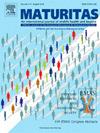更年期、身体成分与非酒精性脂肪肝之间的关系:中国北方的前瞻性队列。
IF 3.9
2区 医学
Q2 GERIATRICS & GERONTOLOGY
引用次数: 0
摘要
背景:更年期、身体成分变化与非酒精性脂肪肝之间的关系尚不明确,从预防非酒精性脂肪肝的角度来看,也缺乏针对围绝经期女性的体重管理策略:方法:在中国开滦队列中纳入了2006年至2017年间的1316名绝经后妇女和3049名绝经前妇女,并随访至2021年。我们使用包括因果中介分析在内的 Cox 回归模型来估计绝经与非酒精性脂肪肝之间的关系,以及身体成分变化的潜在中介效应。我们还探讨了体重变化对更年期与非酒精性脂肪肝之间相关性的影响:结果:与绝经前妇女相比,绝经妇女罹患非酒精性脂肪肝的风险更高(9 年累计发病率为 56.87% 对 48.87%):56.87%对48.80%,调整后危险比=1.219,95%置信区间:1.088-1.365)。超重/肥胖的绝经后妇女(67.24% 对 45.74%,P 2)和腰围正常的绝经后妇女(危险比 = 1.362,95% 置信区间:1.129-1.643)的非酒精性脂肪肝 9 年累计发病率较高(危险比 = 1.434,95% 置信区间:1.168-1.759),内脏脂肪指数(分别为 7.09% 和 7.35%)可以部分解释这一点。体重减轻 3% 或以上或腰围缩小 5% 或以上与绝经前妇女罹患非酒精性脂肪肝的风险降低 31.1%(95% 置信区间:20.8%-40.0%)或降低 14.2%(95% 置信区间:1.1%-25.6%)有关。对于绝经后妇女,体重增加 3% 或更多与非酒精性脂肪肝的风险增加有关,尤其是体重指数低于 23.0 kg/m2 的人:结论:更年期与非酒精性脂肪肝的高风险有关,部分原因是内脏脂肪增加。控制围绝经期妇女的体重可降低患病风险。本文章由计算机程序翻译,如有差异,请以英文原文为准。
Association between menopause, body composition, and nonalcoholic fatty liver disease: A prospective cohort in northern China
Background
The association between menopause, changes in body composition, and nonalcoholic fatty liver disease is not clear, and there is a lack of weight management strategies for perimenopausal women from the perspective of preventing nonalcoholic fatty liver disease.
Methods
A total of 1316 postmenopausal and 3049 premenopausal women in the Kailuan cohort in China between 2006 and 2017 were enrolled and followed up till 2021. Cox regression models, including the causal mediation analyses, were used to estimate the association between menopause and nonalcoholic fatty liver disease and the potential mediation effect of changes in body composition. We also explored the impact of weight changes on the correlation between menopause and nonalcoholic fatty liver disease.
Results
Women who experienced menopause had a higher risk of nonalcoholic fatty liver disease than premenopausal women (9-year cumulative incidence: 56.87 % vs. 48.80 %, adjusted hazard ratio = 1.219, 95 % confidence interval: 1.088–1.365). The nine-year cumulative incidence of nonalcoholic fatty liver disease was higher among overweight/obese postmenopausal women (67.24 % vs. 45.74 %, P < 0.001) and those with abdominal obesity (63.36 % vs. 49.69 %, P < 0.001); however, the hazard ratio of menopause for nonalcoholic fatty liver disease was more evident in women with a body mass index under 23.0 kg/m2 (hazard ratio = 1.434, 95 % confidence interval: 1.168–1.759) and those with normal waist circumference (hazard ratio = 1.362, 95 % confidence interval: 1.129–1.643), which could partially be explained by the visceral fat index (7.09 % and 7.35 % mediation, respectively). Weight loss of 3 % or more or reduction in waist circumference by 5 % or more was associated with a 31.1 % reduction (95 % confidence interval, 20.8 %–40.0 %) or a 14.2 % reduction (95 % confidence interval, 1.1 %–25.6 %) in the risk of nonalcoholic fatty liver disease among the premenopausal women. For postmenopausal women, weight gain of 3 % or more was associated with an increased risk of nonalcoholic fatty liver disease, especially in individuals with a body mass index under 23.0 kg/m2.
Conclusion
Menopause was associated with a higher risk of nonalcoholic fatty liver disease, partially by increasing visceral fat. Controlling weight in perimenopausal women may reduce the risk.
求助全文
通过发布文献求助,成功后即可免费获取论文全文。
去求助
来源期刊

Maturitas
医学-妇产科学
CiteScore
9.10
自引率
2.00%
发文量
142
审稿时长
40 days
期刊介绍:
Maturitas is an international multidisciplinary peer reviewed scientific journal of midlife health and beyond publishing original research, reviews, consensus statements and guidelines, and mini-reviews. The journal provides a forum for all aspects of postreproductive health in both genders ranging from basic science to health and social care.
Topic areas include:• Aging• Alternative and Complementary medicines• Arthritis and Bone Health• Cancer• Cardiovascular Health• Cognitive and Physical Functioning• Epidemiology, health and social care• Gynecology/ Reproductive Endocrinology• Nutrition/ Obesity Diabetes/ Metabolic Syndrome• Menopause, Ovarian Aging• Mental Health• Pharmacology• Sexuality• Quality of Life
 求助内容:
求助内容: 应助结果提醒方式:
应助结果提醒方式:


